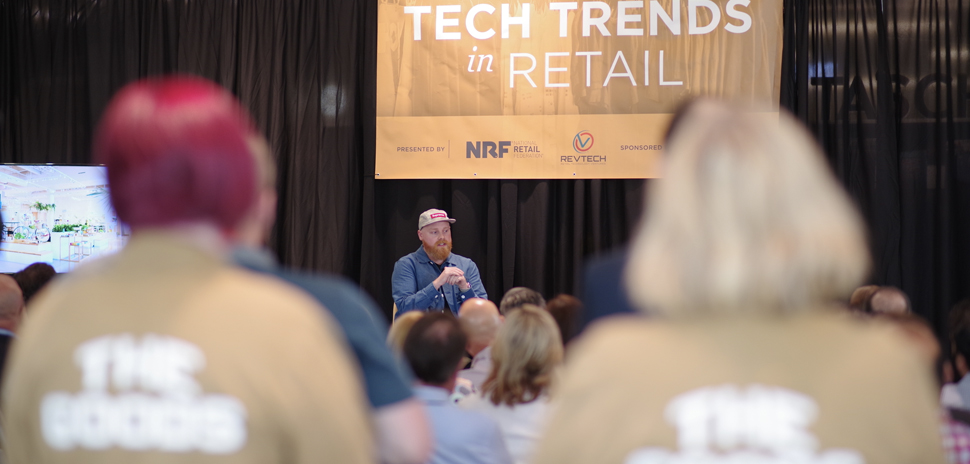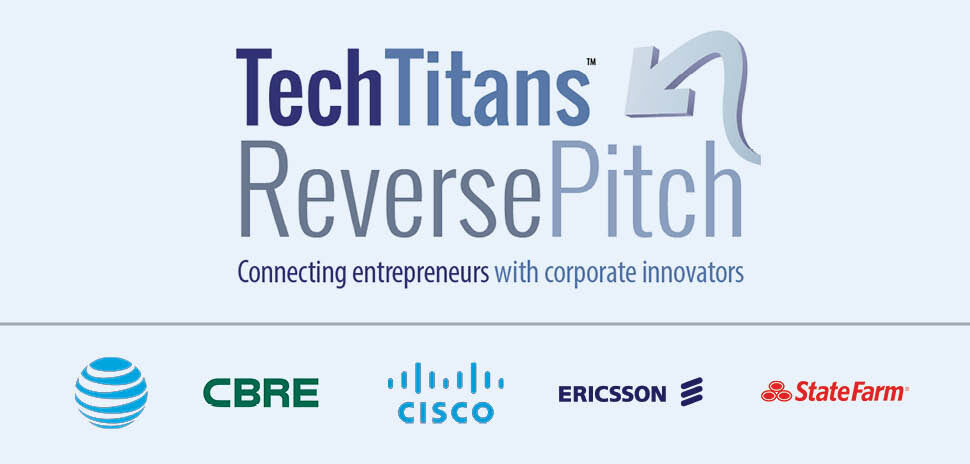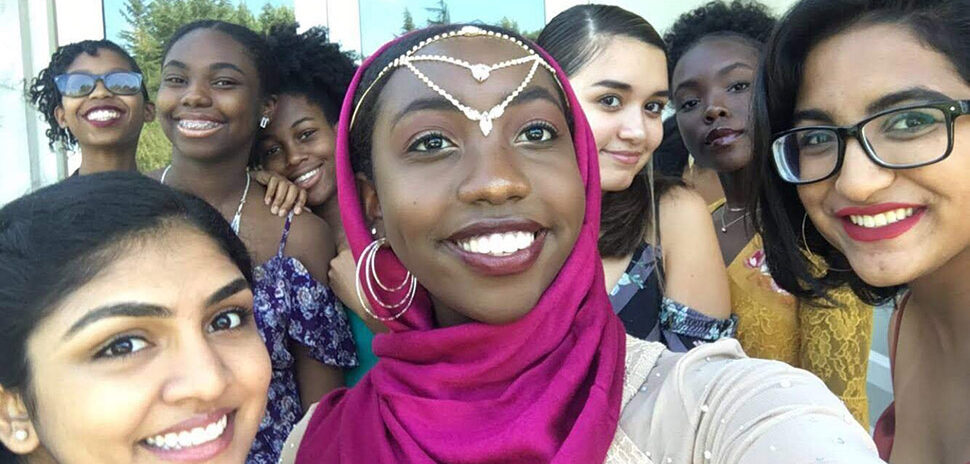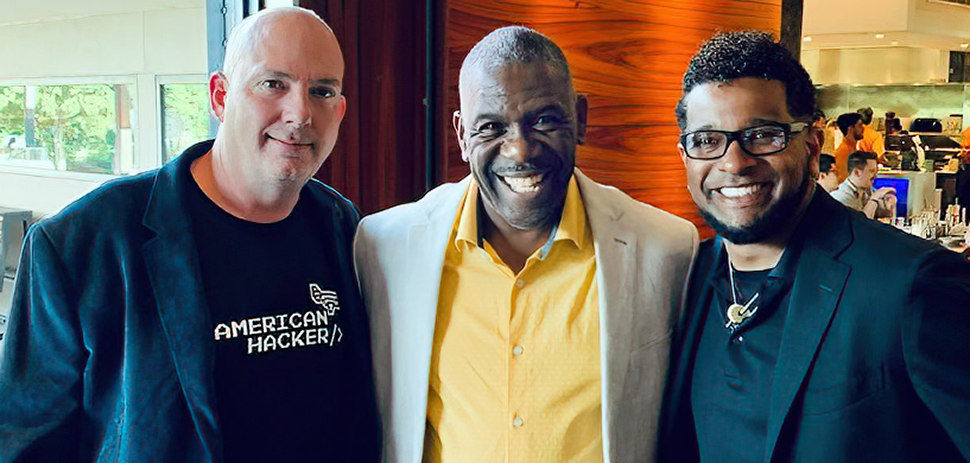Dallas-based VC fund RevTech Ventures is long-known for boosting startups that sit on the intersection of retail and technology. That includes investments, year-round mentorship and support, and hosting a program for accelerator graduates. But that support also includes staying up-to-date on the latest emerging concepts—and how portfolio companies should deploy them.
“We give all our entrepreneurs a little gas in the tank to get up the first hill,” David Matthews, managing director of RevTech, says. “And our mentors are the ones that help them see beyond the first hill, to the next hill, and the next.”
New Retail Concepts and the Technologies that Power Them was the main topic of discussion last week at RevTech’s twelfth semi-annual Tech Trends in Retail event, this time held at the Neighborhood Goods flagship store in Plano.
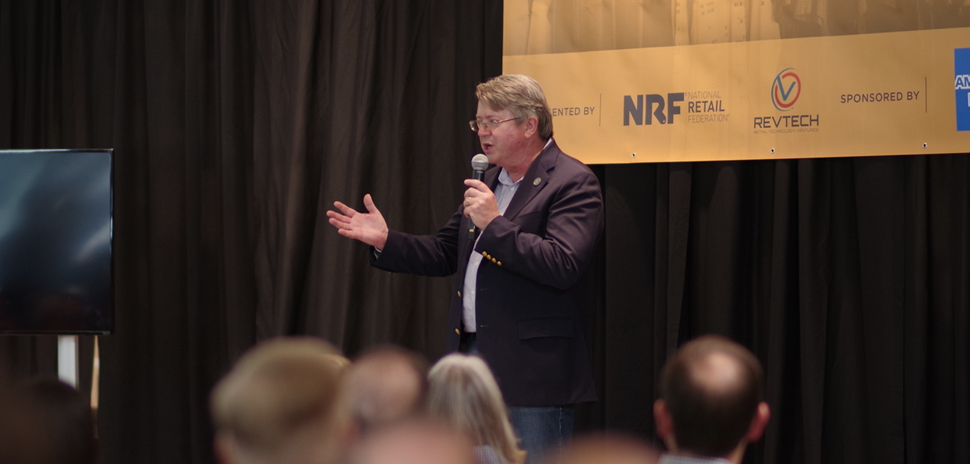
RevTech’s David Matthews was the emcee of the event. [Photo: Courtesy RevTech]
Presented in partnership with the National Retail Federation and sponsored by American Express, the event touched on emerging retail, today’s landscape, and the shopping experience, and gave an inside look at the work being done by innovators in the space.
It also dove into the main objectives RevTech has for brands. “First, keep scaling—online brands have to expand to physical retail,” Matthews says. “Second, as these companies do that, they simply will not tolerate not knowing anything about the customer until the moment of purchase.”
A sit-down with Neighborhood Goods CEO and founder Matt Alexander
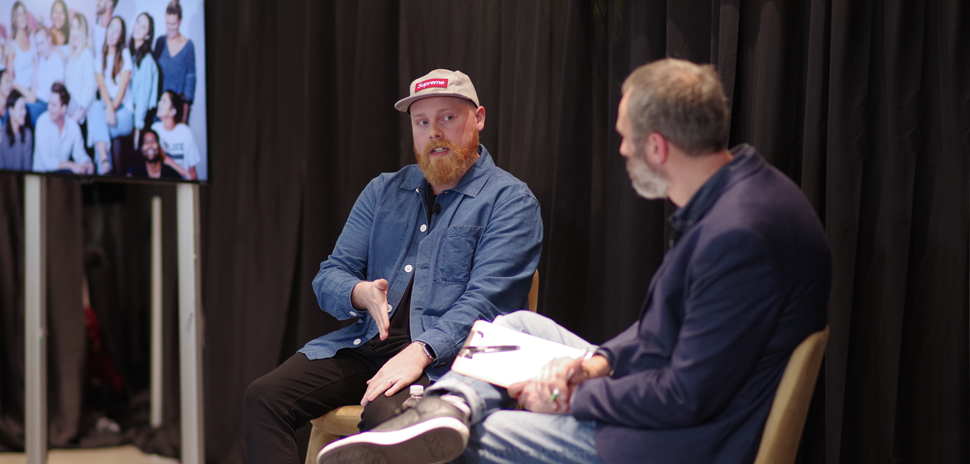
Matt Alexander had an intimate chat with Brian Womack. [Photo: Courtesy RevTech]
Anchoring the two-hour event was a fireside chat with the brains behind next-gen department store Neighborhood Goods: Matt Alexander. Moderated by the DBJ’s Brian Womack, the conversation delved into everything from how Neighborhood Goods uses technology to how it’s fostering an entirely new era of retail.
Here are our favorites (there’s a lot, we know) from what he had to say.
On what’s wrong in retail
“I think the reason we have the opportunity to even exist as a company is largely a result of a lack of self-awareness in the retail industry in general. Steve Dennis, who’s involved with RevTech, has said for a long time that ‘physical retail isn’t dead, boring retail is.’ And that’s become a very significant statement throughout the industry.”
“Your purpose has to extend much further beyond just selling product—it has to be serving a purpose of telling stories. Customer acquisition has to be there for product testing and to capture a modest amount of data. And so that purpose extends so much further beyond what the most traditional department store does.”
On staying true to customers
“We launched with 24 brands, and by the end of this month, we’re going to have about 58 in here active at one time. And the brands in here have never really done wholesale for the most part, and they certainly aren’t in traditional department stores. That’s a pretty big indictment. If your job is to have the most relevant brands in the room, and you can’t bring them into the room, then why should people care?”
“We’ve tried to step in to create something much more communal, something much more perennial, something much more traditional in many respects. We fundamentally believe that the most important thing we can all do is trade the currency of relevance more than anything else. And, deliver a room that can excite people on a very localized basis, bring people together, and generate a certain degree of magnetism that has very little to do with transactions.”
On designing the space
“If you can give people a really positive reason to be in the room, they will come and spend time there. They will come back and they will engender some sense of loyalty to whatever it is you’re doing, whether it’s a personal connection or whether it’s something much more around the products or the service available. That’s why we’ve developed the restaurant. That’s why we have a huge amount of events. And that’s why we have designed the room in a much different way than would be typical and invested a lot of time in very subtle cues.”
“You wouldn’t necessarily notice this upon first glance, but there are murals on the wall that show geometric shapes. And something you pick up after your third visit here is the concrete’s graded a little bit darker when you’re in a brand space. The ceiling goes all the way up when you’re in a brand space, where it’s dropped in the social space in between. All of these are designed to be visual cues that help shape the behavior and the feeling of the room.”
On taking risks
“This perennial sense of ‘let’s create a room and treat people really well’—that’s not that risky of an idea. That idea isn’t going anywhere.”
“It’s trying to think about the problem from the most traditional perspective. We’ve been very fortunate that it is a risky idea, it is unorthodox—but it’s managed to capture the imagination of a lot of really fantastic people, investors, partners, and brands. We’ve only been around for 10 months, so we have plenty of time to mess it up. But fingers crossed it’s going in a great direction so far.”
On competition
“We’re not necessarily competing against the big [department stores] because A) they’re never going to be able to get the sort of brands we’re going to get on the sort of economics we’re able to get; and B) they’re not able to deploy the sort of technology, design, and general concepts we are, on such an agile basis without doing tests. They certainly can’t do it across an ecosystem of hundreds if not thousands [of locations]. And so, we don’t really worry too much there, if anything we see the option for collaboration.”
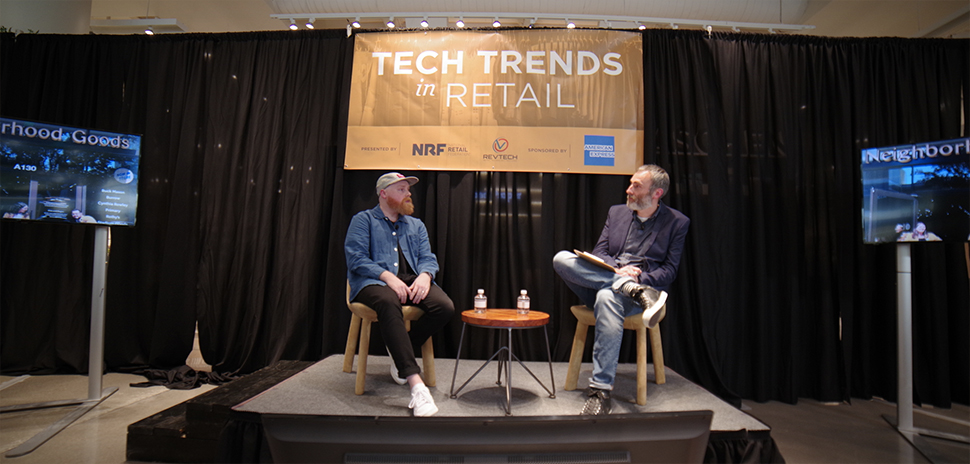
[Photo: Courtesy RevTech]
On Neighborhood Goods’ tech
“I think we in the retail industry are guilty often of not necessarily asking the question of ‘why would I deploy this technology?’ People talk a lot about AR and a lot of these various services you can put into a room, but they’re not necessarily thinking about the true value that might be derived by the consumer on the other end, what friction is created as a result, and whether or not it actually creates something more dignified and fruitful for people.”
“What you’ll find in this room is not a huge amount of screens. We have digital displays that are rotating with information around programming. There are about 26 cameras that are capturing anonymized data around traffic, dwell time, demographics. The entrances have dome cameras that are looking at people as they walk in to capture gender, age, things of that nature. There are the little white boxes you’ll see around the edges of brand space that have two little dots in them that are using computer vision to measure the distance from the top of your head to the ceiling, so we can understand general traffic and behavior.”
“So for us, it’s not about saying ‘Matt walked in and did this.’ It’s much more about saying ‘women in their 20s come in and turn left, while women in their 30s come in and turn right. How can we modify the merchandising strategy?’”
On knowing the shoppers
“We spend a lot of time—probably a disproportionately large amount of time—thinking about dwell time. So for us, obviously, it’s a lot about feeling and being happy and things like that. The intangible element of the room is everything to us. So time is a pretty good measurement for us to understand whether or not people are coming in and having a decent experience, and whether or not they’re coming back.”
“If you treat people well and with respect, it’s likely to create something more meaningful on the other side. And so we spend a lot of time thinking about these metrics that have just about nothing to do with sales, and much more to do with how people are feeling.”
On being in Dallas
“When I was first coming to investors, I was sort of pre-apologized before I said the word ‘Plano’ aloud. If asked, ‘Where is it opening?’ I’d say, ‘In the third fastest-growing city in the country,’ and just find anything I could before saying ‘Plano’ aloud. But honestly, I can tell you very confidently that the notion of launching in Plano has been hands-down the most popular and successful end of the business so far, from a fundraising and brand access perspective.”
“We’re fortunate to have very few physical sorts of natural resources, so everyone just sort of drinks and shops, which is great for us.”
“From a corporate perspective—and a general company perspective—we’re fortunate that as a result of being in a good consumer market, there’s a lot of good consumer talent.”
“From a logistics perspective, we are geographically agnostic, because we’re opening in New York, we’ll be opening in Austin, and we’ll be opening a lot more. And [we’re] able to be three hours, at the most, away from any of these locations.” (Editor’s Note: Neighborhood Goods recently announced it raised $11 million in Series A funding and is opening a third location in Austin early next year.)
On ethics and data collection
“We’re custodians of those brands and the products in this room. We have a real responsibility to them, and so it’s important to us that you don’t suddenly end up on an email list from a brand you shopped with here, or that you start getting ads in a creepy way, or whatever it is. There’s a lot we can do to cater information and experience and improve our offering here and provide feedback to brands. But there’s no utility in us betraying the customer, and for us, the fundamentally most important thing is building that trust and that ongoing relationship.”
Today’s innovators in retail tech
At RevTech’s event, it also showcased two locals currently partnering with Neighborhood Goods: Gardenuity and Detail Provisions Co.
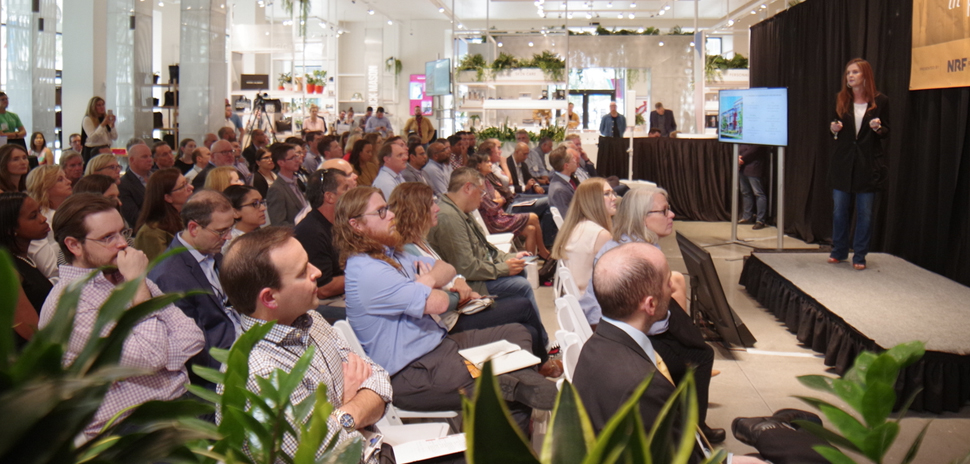
[Photo: Courtesy RevTech]
If you’re unfamiliar with Neighborhood Goods’ concept, think coworking, but for retail.
It essentially acts as a hub for rotating brands that don’t traditionally hold physical storefronts, whether that be digitally native sites, new startups, or direct-to-consumer platforms. Each brand pays a monthly fee to receive its own space inside the 14,000-square-foot store, along with staffing, marketing, and retail design.
Two of those current brands are Gardenuity, a custom container and herb provider that helps shoppers create and maintain their own gardens at home, and Hook & Albert, a high-quality luggage and accessories maker. Detail Provisions Co. is a platform focused on developing digitally native brands; one of them is Hook & Albert.
Tech Trends in Retail also showcased six pitches from founders who had the opportunity to share the emerging tech they’re working on, which the audience could then vote on. The best company was awarded a booth in the Innovation Lab at the 2020 NRF Big Show and a meeting with the American Express venture capital team. Here’s who presented:
-
- Crave Retail
- Brain of the Store (“Audience Favorite” Winner)
- AppleSaaS
- Fuse Inventory
- Glass-Media
- MachineCore
Takeaways were edited for brevity and clarity.
![]()
Get on the list.
Dallas Innovates, every day.
Sign up to keep your eye on what’s new and next in Dallas-Fort Worth, every day.

